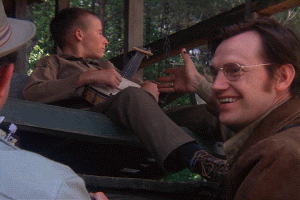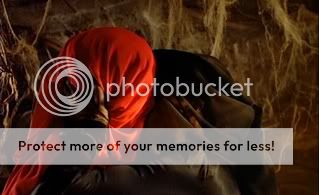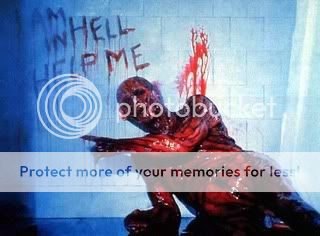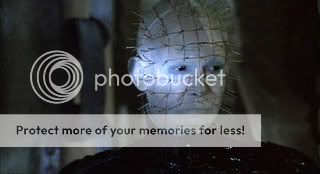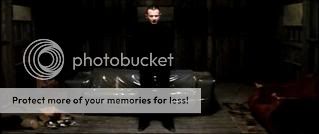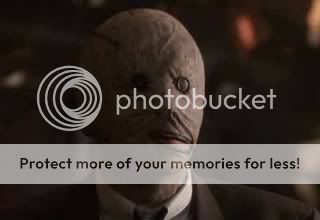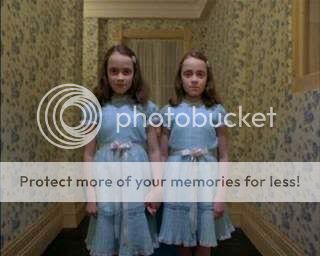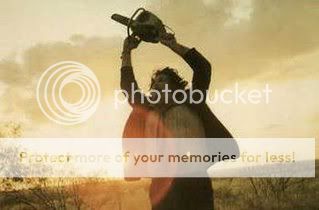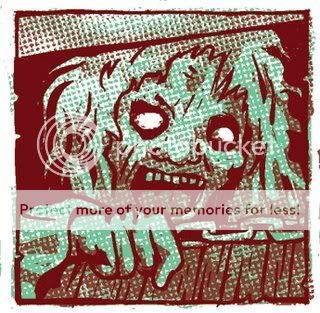Archive for October 31, 2007
Trick or treat!
October 31, 2007How’s this for a treat–don’t quote me on this, but I think my comments are working again!
(At least for new posts. It LOOKS like you can comment on old ones, but you can’t. Still, good enough, right?)
My 35 Favorite Horror Films of All Time (at the moment)
October 31, 20071. 28 Days Later
2. 28 Weeks Later
3. Aliens
4. Barton Fink
5. The Birds
6. The Blair Witch Project
7. Body Double
8. Dahmer
9. Dawn of the Dead (1978)
10. Dawn of the Dead (2004)
11. Deliverance
12. Della’morte Dell’amore (Cemetery Man)
13. The Descent
14. Eraserhead
15. The Exorcist
16. Eyes Wide Shut
17. Heavenly Creatures
18. Hellbound: Hellraiser II
19. Hellraiser
20. Hostel
21. Jeepers Creepers
22. Lost Highway
23. Night of the Living Dead (1968)
24. Nightbreed
25. Psycho (1960)
26. The Ring
27. Rosemary’s Baby
28. The Shining (1980)
29. Shivers
30. The Silence of the Lambs
31. The Texas Chain Saw Massacre (1974)
32. The Thing (1983)
33. The Village
34. War of the Worlds (2005)
35. The Wicker Man (1973)
Watch one tonight! Happy Halloween!
And no Red Dragon!
October 31, 2007AOL/Moviefone has finished up its countdown of the 31 Best Horror Movies of All Time (click the link for the whole shebang). Unlike that goofy Time/Richard Corliss list, this one’s very, very solid. There are a lot fewer surprises (maybe some in where the selections are ranked, but not in the selections themselves)–and that’s good! If you’re honestly trying to come up with a list of the 31 greatest horror films of all time, rather than just run down your own favorites or impress people with your catholic tastes, the list should be full of the standards. Indeed, most of the selections here that did make me say “huh!” are ones that mainstream audiences still thrill to but we horror cognoscenti largely ignore (Scream, say, or The Sixth Sense), and most of the ranking decisions that took me aback were in the same vein (the high placement of the initial Nightmare on Elm Street and Friday the 13th installments, for example, the latter complete with an anachronistic hockey-mask-Jason photo, the lists’s one big misstep). It was also satisfying, and comparatively bold when you look at Corliss’ list, to see a film as recent as The Descent make the grade. Well done.
The Blogslinger: Blogging The Dark Tower, October 2007–Day 31
October 31, 2007Happy Halloween!
Read: Wolves of the Calla–“Prologue: Roont”; “The Face on the Water”; “New York Groove”
I wouldn’t call what King’s doing in these opening sections subtle–repeating certain unexplained phrases regarding life in the Calla over and over so we make sure to catch that there’s a mystery behind them, giving Father Callahan from ‘Salem’s Lot an entrance as big as a Ray Harryhausen monster, brewing up a nice hot glass of instant 19 numerology (just add incessant repetition!), even indulging in a conversation between Roland’s ka-tet about mixed-genre storytelling in which the gunslinger all but turns and winks at the audience. King’s not so much guiding the reader as riding herd.
But while it may not be subtle, it’s definitely intriguing. Years of toiling away in comics criticism have taught me that I should have nothing but contempt for those “hey, look, it’s a character I’m already familiar with!” reveals, but even though I knew it was coming eventually I was still thrilled by Father Callahan’s appearance here in Roland’s world. (Shouldn’t he be a vampire by now, though?) I mean, those kinds of continuity-porn moments are a big part of the Dark Tower-verse’s structure, so it would be churlish to deny myself the pleasure of them because Green Lantern is inaccessible to new readers.
The set-up in this little farming village hooked me, too. It was smart of King to root the prologue in this farmer character Tian. He’s not super-bright (though apparently he’s Mensa material compared to the Calla’s other residents, not even counting the “roont” ones), he’s not super-nice; in fact, he comes across as a bit of a jerk. But that makes his rage against the raiders who loot his twin-heavy town of half their children every generation, then send them back as retarded giants, all the more convincing. If there was any way at all he could stand to take the easier way out of the situation, we know he’d do it. No such luck. He’s as mad as hell and he’s not going to take this anymore.
This leads to the most spaghetti-Western twist in the series so far: the townsfolk, led by Tian and Father Callahan, are going to hire Roland and his band of gunslingers to defend against the raiding Wolves. I for one would love to see the book serve up a straightforward, lead-slinging Western action-adventure, maybe with the occasional robot or vampire thrown in for good measure. I don’t think that’s what I’m going to get–the book’s size, that dopey number 19, and the return of the central-casting mobsters from The Drawing of the Three during Jake, Eddie, and Oy’s interdimensional sojourn back to New York indicate otherwise–but there will be water if God wills it.
My family’s always been in meat.
October 31, 2007I became a vegetarian two years ago, and I’m married to a vegan recovering anorexic who initially became a vegetarian because of upsetting scenes in the horror movies Wolf and Jurassic Park. Naturally, I’ve picked up on the relationship between horror and carnivorousness. (You might have noticed this in my “state of the beast” posts, among others.)
A pair of noteworthy posts elsewhere make this case. First up is David Carter of Not Coming to a Theater Near You on PeTA’s Chew on This: 30 Reasons to Go Vegetarian, which views the animal rights organization’s bloody documentary on the treatment of animals by the meat industry through a horror lens.
Meanwhile, Lindy Loo of Yeah, That “Vegan” Shit (and, not coincidentally, horror blog Come Play with Us, Danny…) examines the anti-meat implications of arguably the meat-movie (rimshot!) masterpieces, The Texas Chain Saw Massacare and Hostel–and Motel Hell for good measure.
Peeling back the layers
October 30, 2007The Onion AV Club has posted two lengthy, boffo pieces on horror in time for Halloween. First is Noel Murray’s film-by-film overview of the Friday the 13th franchise, with special attention paid to the ways each film is a creature of its era. Lately I’ve been almost preoccupied with how gratuitous violence works in a movie, so this is like crack to me. Highly recommended.
Next is an imaginary 24-hour horror movie marathon curated by Eli Roth. Listening to Roth repeatedly place himself in the company of the likes of John Carpenter and Sam Raimi indicates just how much the guy believes his own press at this point. Actually, perhaps “believes the press he thinks he should have” is a more accurate way of putting things post-Hostel: Part II. But that aside, he’s made many interesting choices from a range of eras and styles, and has some intriguing things to say about them, from their influence on his own work (which only feels like he’s paying himself a compliment some of the time, and frequently yields insights like his characterization of the second half of Hostel as driven by a Vanishing-derived compulsion to know) to an almost elegiac appreciation for the kinds of horror films that could never get made today (the original Wicker Man, for example). Also highly recommended, and with the hope that he eats some humble pie and finds his way again.
Quote of the day
October 30, 2007Watching the film once again, Romero’s carefully calculated deconstructions on social woes of the time seem most brilliant in their simultaneously identifying the film as a distinctly American work rooted in the cultural anarchy of the 1970’s as well as one packed with universal truths on the human condition, borders of time and place notwithstanding. The former packs the greatest punch in the third-act war between the main protagonists holed up in their shopping mall fortress and the military convoy that overruns them (bringing the zombie population flooding back in), stealthily evoking not simply the tensions between pacifist movements and more aggressive social orders of the time, but any scenario in which men turn on each other in the face of greater disorder (in other words, look at any historical timeline and pick your example of choice)….In a prolonged television debate meant to inform viewers on how to handle the crisis at hand, a lone scientist stresses the importance of exterminating the dead “without emotion.” How fitting, then, that the soldiers who underestimate the zombies – treating them more like disposable hunting targets worthy of ridicule than a lethal force to be reckoned with – are generally those who find themselves being torn limb from limb.
—Rob Humanick on Dawn of the Dead.
I feel like I pick on another one of Humanick’s zombie-blogathon posts every day, but the people who overrun the mall simply aren’t soldiers in a military convoy–they’re a biker gang. Meanwhile, the people who supposedly represent “pacifist movements” in this formulation include two SWAT cops.
No, seriously, Red Dragon?
October 30, 2007Time Magazine has posted its list of the Top 25 Horror Movies of all time, by critic Richard Corliss. It’s pretty ridiculous. Red Dragon? It includes a lot of films that are fondly remembered but not in serious contention for the canon–Dead Alive, Black Sunday, freaking Blood Feast. And then there are the countless omissions–obviously these things are subjective, but the absence of The Shining, The Blair Witch Project, Dawn of the Dead, and Rosemary’s Baby seems particularly glaring, and that’s before we get into more tenuous or debatable territory like The Sixth Sense, The Ring, Hellraiser, Evil Dead 2, Henry, Suspiria, A Nightmare on Elm Street, Hostel, 28 Days Later, etc. And again, The Silence of the Lambs doesn’t make the cut but Red Dragon does. Finally, the too-clever-by-half non-horror selections are pretty preposterous–Bambi? Arrival of a Train? I understand what they’re saying, but those films aren’t horror films, they’re movies that had parts that scared people. The flying monkeys scared the shit out of every little kid in America but The Wizard of Oz is not a horror movie.
Lists like this one really make me question the value of listmaking as part of the critical enterprise, because the “hey, it started a conversation” thing is only worthwhile if the conversation doesn’t muddy the waters and force knowledgeable people to spend valuable time smacking down stupidity. This goes double when the list is presented not as one dude’s opinion but by a publication that presumes authority on all topics about which it speaks.
The Blogslinger: Blogging The Dark Tower, October 2007–Day 30
October 30, 2007Read: Wolves of the Calla–The Final Argument
Another book, another infodump of stuff that had never been revealed in the actual story. The magical crystal balls are called Bends o’ the Rainbow. The guy who accidentally ran Jake over when he was pushed into the street by Jack Mort, who’s now called “Walter’s representative on the New York level of the Dark Tower,” was mafia don Enrico Balazar. The Turtle’s name is Maturin. Roland is the last seppe-sai (“death-seller”). Books Two, Three, and Four are subtitled “Renewal,” “Redemption,” and “Regard” to match Book One’s “Resumption” and this volume’s “Resistance.”
And yet King still can’t bring himself to make it clear that Walter is the same person as Marten Broadcloack/Richard Fannin/Randall Flagg/John Farson/The Good Man/The Walkin Dude, just in disguise. At the beginning of the Argument he even appears to use the names “Walter” and “Marten” interchangeably, with no explanation as to who this “Marten” character might be.
Also, the letter R is not the 19th letter of the alphabet. Come on, man.
And I feel fine
October 30, 2007Bruce Baugh sings the praises of Children of Men and 28 Weeks Later, my two favorite films of the past year and harrowing post-apocalyptic narratives both. Interestingly, he cites Children of Men‘s long-take action and suspense sequences, singled out by many critics as a case of ostentatious filmmaking getting in the way of emotional immediacy, as doing precisely the opposite–recreating the emotional endlessness of traumatic moments in filmic terms. That feels right to me.
I think criticism of the technique used in those set pieces bespeaks a certain conservatism among film critics in its implicit belief that movies use the stuff of moviemaking at the expense of emotional resonance.
What he said
October 30, 2007I’m linking to Tom Spurgeon’s post in praise of the current state of comics because I think it’s at least as important to read as the recent complaints about same by Craig Yoe and Frank Santoro and Heidi MacDonald. Hell, I was going to write something along the lines of Tom’s post (particularly the “Craft and Story Are Valued as Never Before” section) myself, but my version would have come out something like “if you are interested in and knowledgeable about comics enough to write about them but still think they’re in dire artistic straits right now, WHAT THE HELL????” so I didn’t.
Pardon my freedom, but holy fuck
October 30, 2007Brian Ralph presents the Zombie Hall of Fame, parts one and two.
There’s more at the links, but not enough, goddammit. I want to see Flyboy, Bub, Big Daddy, the priest from 28 Weeks Later, the little girl from the Dawn remake, the mom from Dead Alive…and then I want to pay money to own these things, so Brian, if you’re listening, let’s make this happen.
I always thought they should set an issue of Daredevil there
October 30, 2007Troma is selling its Hell’s Kitchen walk-up and moving to Long Island City due to financial woes. I spent a summer in that building, and I have, well, let’s call them vivid memories of the place. In a way I feel like the McDonald’s next door that Lloyd Kaufman has blamed for Troma’s rat problem in every interview he’s done for the last decade has won some sort of titanic struggle for the soul of that block.
The Blogslinger: Blogging The Dark Tower, October 2007–Day 29
October 29, 2007Read: The Gunslinger (revised)–“The Slow Mutants”; “The Gunslinger and the Man in Black”
This page enumerates the non-grammatical/stylistic differences between the original and revised Gunslingers. IIRC it only contains three spoilers that made me want to chuck my laptop out the window, which is a minor miracle when it comes to online reference material about fiction. Part of me feels like I could have just read the list and saved myself the trouble of reading the book, but it’s probably worth seeing the changes in context. They’re hard enough to wrap your head around as it is without having a full-fledged reading experience to help you internalize them.
So, Jake is dead, and unless the lobstrosity attack that kicks off The Drawing of the Three is to be interpreted as karma-by-shellfish, Roland still doesn’t get his comeuppance for letting the kid die. The man in black now openly cops to being both Marten and Walter during his post-chase palaver with the gunslinger; the servile relationship of the latter to the former is redacted, as is the one between Marten/Walter and the Ageless Stranger, who is now called Legion and not Maerlyn. The Beast has been removed altogether, replaced by a king with a red hand–the crimson king, I presume. And now Roland basically says “yeah, right” when he comes to at the end of his mystical chat with Walter to find the dark man’s bones on the ground.
In other words, everything you thought you knew about the villain of the series is wrong. Listen, I appreciate King wanting to go in what he thought was a better direction, but when you have to change that much about the second most important character in the series, whose nature defines the quest of the first most important character in the series, maybe, to quote LCD Soundsystem, it’s late for revision?
Finally, my guess is that the series ends with the gunslinger stuck in some kind of moebius-strip time-loop. I can live with that, I guess. It’s slowly dawned on me that Roland’s world is what things would look like if Flagg really won at some point, and that’s too cool to let the good guys screw up by winning themselves.
Carnival of souls: talk about…horror movies, shoobeedoobeedoowop
October 29, 2007Keith Uhlich calls our attention to several interesting pieces on horror films at Reverse Shot, part of their “A Few Great Pumpkins” horrorblogging series this year.
The funny thing about Reverse Shot is that they published maybe the most spectacularly wrong-headed horror movie review I’ve read all year, Andrew Tracy’s angrily dismissive take on 28 Weeks Later. (I gave that review the business here and reviewed the film myself here.) So you might be forgiven for ignoring a horror blogathon that kicks off by reiterating his sentiments and decrying 28 Weeks Later‘s “useless ‘verité.'” But lo, the intro quickly rights itself by lambasting the “tired excess” of Robert Rodriguez’s “waste-of-space” Planet Terror half of Grindhouse. (Agreed.) Best of all, it refers to Hostel: Part II as “loathsome, self-congratulatory” and “the granddaddy of all badness,” all of which it is.
The critical schizophrenia continues at the site’s review for Hostel: Part II itself, by Michael Koresky. This has to be one of the juiciest bits of horror criticsm I’ve read in some time, because it’s split about evenly between insights with which I agree so emphatically I’m tempted to have them tattooed on my person and real head-slapping howlers. Most of the latter arise from Koresky’s conflation and dismissal of the two Hostel films, which to me are as different as night and day–so different that each day I grow more convinced that the first one was a fluke. Once again he repeats the fatuous notion that Hostel merely presents torture for the gratification of the audience in the most businesslike and unartful way possible, and I’m just baffled that you could watch a movie with (just a few examples) that factory shot or the American businessman’s monologue or the heart-stopping cat-and-mouse game at the end or that meaning-laden conversation about staying in the closet and think that there’s nothing going on in that movie.
But for every head-scratcher, there’s a passage like this:
The need to align epochs of genres, especially horror, with sociopolitical realities has always made for neatly encapsulated criticism and terrific sound bites, but this sort of assessment works better in retrospect. Those who make up this contingent of new filmmakers are from such disparate backgrounds and sensibilities, nationally and otherwise, that to group them together as some kind of coalition comes across as desperate at best, disingenuous at worst. The truth is that the need to place instantaneous social readings on this new wave of horror willfully ignores the pathetic opportunism behind some of the films, as well as the savvy genre reclamation of others. Those influential Seventies horror films, from the dingy cult basement specials of Wes Craven to the multiplex delights of John Carpenter, were for the most part recouped decades later as trenchant post-Vietnam meditations on social disillusionment as a way of putting a neat bow atop a tumultuous past.
Heh, indeed! And the thing ends with an encomium to The Blair Witch Project, which of course is the way to my heart.
And oh, while we’re on the subject of Hostel, Jason Adams reports that the director’s cut of Hostel–and how annoying is it that the unrated cut I already own isn’t the director’s cut? If Roth cares about the fans as much as he says he does, he wouldn’t participate in this kind of transparent, almost clichéd DVD-rebuying huxterism, but oh well–makes a change to the original ending that’s supposedly a vast improvement. I wasn’t wild about that ending, though not for Jason’s reasons–I didn’t read it as homophobic catharsis, but simply as a not-particulary-believable move for the characters involved. Maybe that’s changed.
Back to Reverse Shot, in a move sure to make Jason happy, their aforementioned “Great Pumpkins” series contains a review of Paperhouse (by Robbie Freeling), a movie that I don’t think I’ve ever seen discussed outside of horror blogs.
Better still, Freeling also looks at Philip Kaufman’s Invasion of the Body Snatchers with the explicit goal of giving it the credit it’s due as an unqualified classic of the genre. I think he’s right. I don’t know any horror fan (or even casual, Halloween-time horror-movie watcher) who hasn’t seen that movie and loved it, and gotten the bejesus scared out of them at least twice (you can probably guess when if you’ve seen it), and yet even I rarely give it the time of day. I’m thinking the reason it’s not talked about in the same way and with the same frequency as, say, John Carpenter’s comparable ’50s-scifi-parable-as-body-horror-and-paranoia remake The Thing is because it wasn’t made by a genre stalwart like Carpenter, but by the guy who did The Right Stuff.
Follow those links and read is my advice.
Dead wrong
October 29, 2007Like an ugly duckling, Day of the Dead took some time to get the love it deserved (and even then it has remained a black sheep amongst its brethren) – a scenario not uncommon to works of art that tell people what they simultaneously need to know and want not to hear.The film was – and to a large extent, remains – a victim of its own implicit place in film history; like the occasionally artful summer blockbuster, Romero’s third “Dead” entry is routinely examined and dismissed less for its own qualities than its “failure” to conform to the expectations unfairly assigned to it sight unseen, here as a zombie movie sequel indebted to two highly lauded works come before. Night of the Living Dead and Dawn of the Dead were both brilliant and easily among the greatest horror films ever made, but that Day of the Dead doesn’t follow the expected trilogy arc of capping off its saga with all-out climactic spectacle is hardly an inherent strike against it. Part of this degrading misconception lies in the fact that Romero’s original vision was cut short by budgetary restraints over issues with the increasingly more powerful MPAA rating system, the final result being far from the originally conceived “Raiders of the Lost Ark with zombies”, and gore hounds subsequently decrying the relative lack of visceral bloodshed (regardless of the fact that, during its brief moments of splatter, Day features some of the sickest zombie action ever filmed).
—Rob Humanick on Day of the Dead.
Is this really accurate? I know that supposedly the initial audiences were let down by the movie’s failure to be as large-scale in comparison to Dawn as Dawn was to Night, but I’ve never heard anyone talk about it on those terms in any present-day conversations. I’ve certainly never heard anyone “decry the relative lack of visceral bloodshed,” since it’s easily the goriest, most disgusting entry in the trilogy. The reason most people I know who don’t like it don’t like it is that they feel it’s boring and slow and sloppily paced and the characters are poorly written and acted.
I happen to like it more each time I see it, but in the defense of those who don’t, I hardly think this is because “they can’t handle the truth!” or what have you.
Quote of the day
October 29, 2007Why does Batman laugh so much in All Star Batman and Robin, the Boy Wonder?
There’s a number of possible, more-or-less mutually inexclusive answers.
First, maybe writer Frank Miller is completely fucking nuts, and simply has no control over what his fingers are doing anymore, which, naturally, is why he’s been entrusted with creative roles on expensive movie projects.
You’d be surprised how many times this theory has been advanced to me by a straight face by people you’d think would know better. Or I dunno, maybe you wouldn’t.
You like this face?
October 29, 2007What was my worst Halloween costume ever? Find out at this week’s Horror Roundtable–the answer may surprise you!
The Blogslinger: Blogging The Dark Tower, October 2007–Day 28
October 28, 2007Read: The Gungslinger (revised)–“The Oracle and the Mountains”
In reading The Gunslinger again (for the first time), I’ve discovered part of what made The Drawing of the Three feel so lame by comparison. In Book One, the gunslinger (calling him Roland in this book’s context doesn’t feel right) reacts to any tenderness he feels toward Jake with shock bordering on horror. Eventually he allows himself to love the kid, but puts it aside the second the man in black makes it clear that he will face a choice between saving Jake and chasing the Tower. Finding and then killing Jake adds another log on the simmering fire of the gunslinger’s guilt, but it doesn’t change him in any fundamental way. As we’re constantly reminded, he’s got a lot of dead friends, many of whom ended up that way thanks to him.
But along comes Book Two, and by the end the guy’s a changed man, using the idioms of, genuinely caring about and taking risks on behalf of other people. Two of the most irritating people of all time, by the way–a junkie who never shuts up and a woman with a split personality, half of which is psychotic, who also never shuts up. We’re supposed to buy that these clowns peel away Roland’s layers to find the still-warm heart within, but not Jake? Bullroar.











